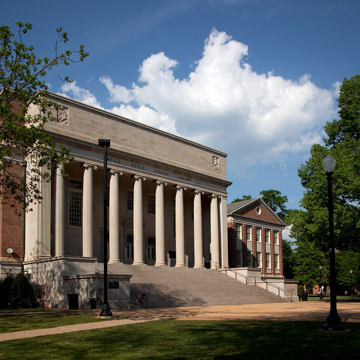The Amelia Gayle Gorgas Library, designed by Birmingham architect Hugh Martin in 1939, is located in the center of the north side of the Main Quadrangle, facing the President’s Mansion. Thoroughly trained in the Beaux-Arts tradition, Martin created a finely detailed structure that related both in style (Classical Revival) and scale to the other buildings surrounding the quadrangle. At the same time, the library building literally turns it back to the Victorian structures in Woods Quadrangle. Martin sited the building so that the massive entrance stairs rest precisely on the northern half of the stone foundations of the antebellum Rotunda that served as the university’s first library. The five-part, red brick structure raised on a stone basement consists of a central block featuring a colossal stone Ionic colonnade surmounted by a high stone attic adorned with plaques symbolizing writing and publishing. This central section originally housed the foyer, main desk, and card catalogue, with tiers of books stacks located in the rear. The central block is flanked on the east and west by slightly lower gabled wings housing reading rooms.
References
Mellown, Robert Oliver. The University of Alabama: A Guide to the Campus and its Architecture. Tuscaloosa: University of Alabama Press, 2013.

